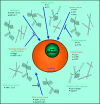Cartilage morphogenetic proteins: role in joint development, homoeostasis, and regeneration
- PMID: 14532155
- PMCID: PMC1766760
- DOI: 10.1136/ard.62.suppl_2.ii73
Cartilage morphogenetic proteins: role in joint development, homoeostasis, and regeneration
Abstract
Background: Articular cartilage homoeostasis is critical for joint function. The steady state homoeostasis of articular cartilage is a balance between anabolic morphogens such as cartilage derived morphogenetic proteins (CDMPs) and bone morphogenetic proteins (BMPs) of the BMP family and catabolic cytokines such as interleukin (IL)1, IL17, and tumour necrosis factor alpha. Although bone and articular cartilage are adjacent tissues, there is a profound difference in their regeneration potential. Bone has the highest potential for regeneration. On the other hand, articular cartilage is recalcitrant to repair.
Objective: To examine the hypothesis that the feeble innate regeneration ability of cartilage is due to the preponderance of catabolic cytokines such as IL1 and IL17.
Results: During a systematic investigation of CDMPs and cytokines IL17B (chondroleukin) was found in bovine articular cartilage.
Discussion and conclusions: BMP-7 and IL17B are present in articular cartilage and synthesised in chondrocytes as shown by northern blots and real-time reverse transcription-polymerase chain reaction. The coexistence of anabolic morphogens and catabolic cytokines in articular cartilage has important implications for cartilage homoeostasis and regeneration. The networks of signalling systems of morphogens and cytokines determine the net capacity for regenerative morphogenesis of articular cartilage. Finally, the feeble innate capacity for articular cartilage may be improved by targeted therapy by soluble receptors to block catabolic cytokines.
Figures

References
Publication types
MeSH terms
Substances
LinkOut - more resources
Full Text Sources
Other Literature Sources

